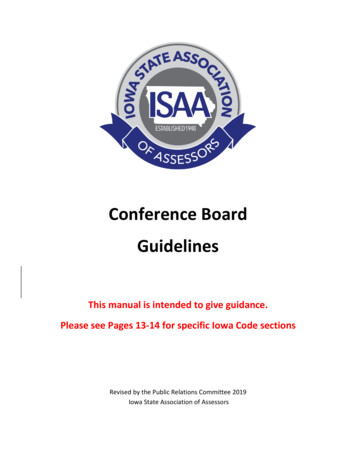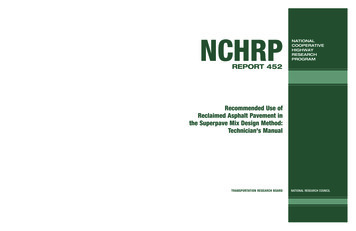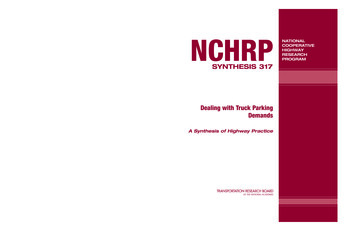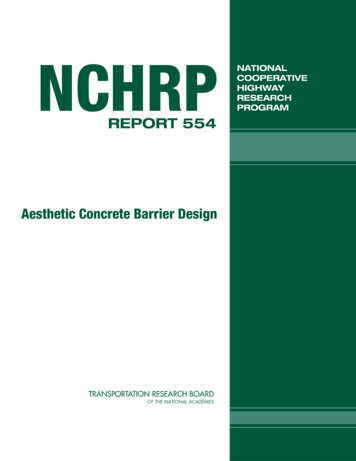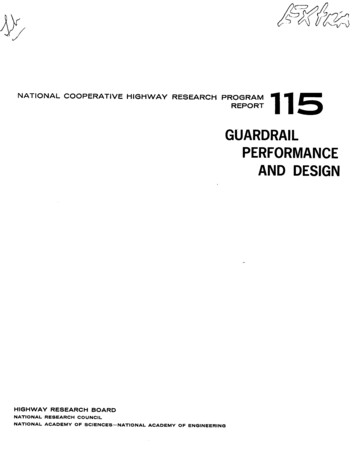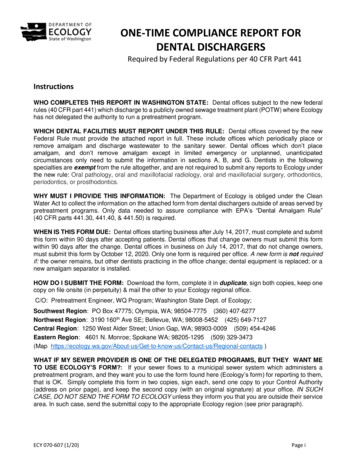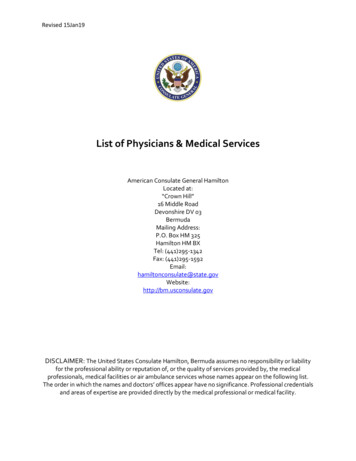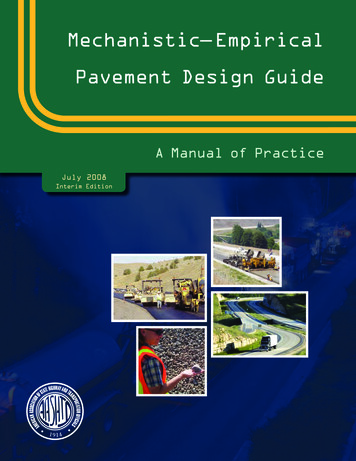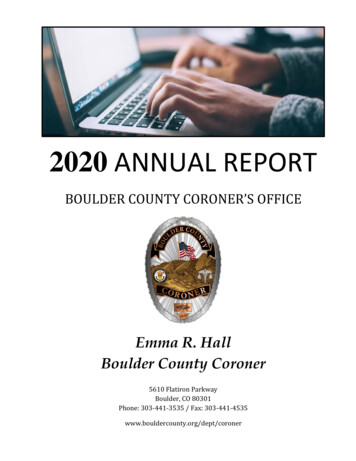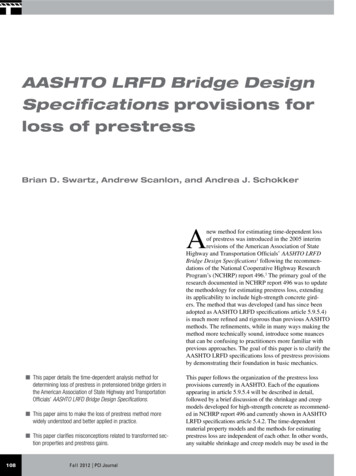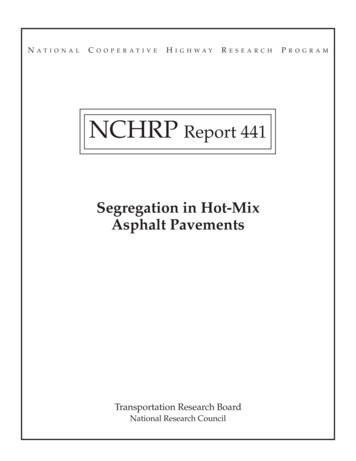
Transcription
NAT I O N A LCO O P E R AT I V EHI G H WAYRE S E A R C HNCHRP Report 441Segregation in Hot-MixAsphalt PavementsTransportation Research BoardNational Research CouncilPR O G R A M
TRANSPORTATION RESEARCH BOARD EXECUTIVE COMMITTEE 2000OFFICERSChair: Martin Wachs, Director, Institute of Transportation Studies, University of California at BerkeleyVice Chair: John M. Samuels, VP-Operations Planning & Budget, Norfolk Southern Corporation, Norfolk, VAExecutive Director: Robert E. Skinner, Jr., Transportation Research BoardMEMBERSTHOMAS F. BARRY, JR., Secretary of Transportation, Florida DOTJACK E. BUFFINGTON, Associate Director and Research Professor, Mack-Blackwell National Rural Transportation Study Center, University of ArkansasSARAH C. CAMPBELL, President, TransManagement, Inc., Washington, DCANNE P. CANBY, Secretary of Transportation, Delaware DOTE. DEAN CARLSON, Secretary, Kansas DOTJOANNE F. CASEY, President, Intermodal Association of North America, Greenbelt, MDJOHN L. CRAIG, Director, Nebraska Department of Roads, Lincoln, NBROBERT A. FROSCH, Senior Research Fellow, John F. Kennedy School of Government, Harvard UniversityGORMAN GILBERT, Director, Institute for Transportation Research and Education, North Carolina State UniversityGENEVIEVE GIULIANO, Professor, University of Southern California, Los AngelesLESTER A. HOEL, L. A. Lacy Distinguished Professor, Civil Engineering, University of VirginiaH. THOMAS KORNEGAY, Executive Director, Port of Houston AuthorityTHOMAS F. LARWIN, General Manager, San Diego Metropolitan Transit Development BoardBRADLEY L. MALLORY, Secretary of Transportation, Pennsylvania DOTJEFFREY R. MORELAND, Senior Vice President Law and Chief of Staff, Burlington Northern Santa Fe Corporation, Fort Worth, TXSID MORRISON, Secretary of Transportation, Washington State DOTJOHN P. POORMAN, Staff Director, Capital District Transportation Committee, Albany, NYWAYNE SHACKELFORD, Commissioner, Georgia DOTMICHAEL S. TOWNES, Executive Director, Transportation District Commission of Hampton Roads, Hampton, VATHOMAS R. WARNE, Executive Director, Utah DOTARNOLD F. WELLMAN, JR., Vice President, Corporate Public Affairs, United Parcel Service, Washington, DCJAMES A. WILDING, President and CEO, Metropolitan Washington Airports AuthorityM. GORDON WOLMAN, Professor of Geography and Environmental Engineering, The Johns Hopkins UniversityDAVID N. WORMLEY, Dean of Engineering, Pennsylvania State UniversityMIKE ACOTT, President, National Asphalt Pavement Association (ex officio)JOE N. BALLARD, Chief of Engineers and Commander, U.S. Army Corps of Engineers (ex officio)KELLEY S. COYNER, Research and Special Programs Administrator, U.S.DOT (ex officio)ALEXANDER CRISTOFARO, Office Director, U.S. Environmental Protection Agency (ex officio)MORTIMER L. DOWNEY, Deputy Secretary, Office of the Secretary, U.S.DOT (ex officio)NURIA I. FERNANDEZ, Acting Administrator, Federal Transit Administration, U.S. DOT (ex officio)JANE F. GARVEY, Federal Aviation Administrator, U.S.DOT (ex officio)EDWARD R. HAMBERGER, President and CEO, Association of American Railroads (ex officio)CLYDE J. HART, JR., Maritime Administrator, U.S.DOT (ex officio)JOHN C. HORSLEY, Executive Director, American Association of State Highway and Transportation Officials (ex officio)JAMES M. LOY, Commandant, U.S. Coast Guard (ex officio)WILLIAM W. MILLAR, President, American Public Transportation Association (ex officio)ROSALYN G. MILLMAN, Acting Administrator, National Highway Traffic Safety Administration, U.S.DOT (ex officio)JOLENE M. MOLITORIS, Federal Railroad Administrator, U.S.DOT (ex officio)VALENTIN J. RIVA, President and CEO, American Concrete Pavement Association (ex officio)ASHISH K. SEN, Director, Bureau of Transportation Statistics, U.S.DOT (ex officio)KENNETH R. WYKLE, Federal Highway Administrator, U.S.DOT (ex officio)NATIONAL COOPERATIVE HIGHWAY RESEARCH PROGRAMTransportation Research Board Executive Committee Subcommittee for NCHRPMARTIN WACHS, Institute of Transportation Studies, University of California atBerkeley (Chair)LESTER A. HOEL, University of VirginiaJOHN C. HORSLEY, American Association of State Highway and TransportationOfficialsJOHN M. SAMUELS, Norfolk Southern CorporationWAYNE SHACKELFORD, Georgia DOTROBERT E. SKINNER, JR., Transportation Research BoardKENNETH R. WYKLE, Federal Highway AdministrationProject Panel D9-11Field of Materials and ConstructionArea of Bituminous MaterialsFREDDY L. ROBERTS, Louisiana Technical University (Chair)DENIZ SANDHU, New York State DOTL. JENISE CARTER, Oregon DOTDONALD WATSON, Georgia DOTDOUGLAS L. COLEMAN, Haslett, MIJACK WEIGEL, JR., Payne & Dolan, Inc., Waukesha, WICAROLINE HERRERA, Texas DOTFREDERICK HEJL, TRB Liaison RepresentativeLONNIE S. INGRAM, Kansas DOTProgram StaffROBERT J. REILLY, Director, Cooperative Research ProgramsCRAWFORD F. JENCKS, Manager, NCHRPDAVID B. BEAL, Senior Program OfficerLLOYD R. CROWTHER, Senior Program OfficerB. RAY DERR, Senior Program OfficerAMIR N. HANNA, Senior Program OfficerEDWARD T. HARRIGAN, Senior Program OfficerCHRISTOPHER HEDGES, Senior Program OfficerTIMOTHY G. HESS, Senior Program OfficerRONALD D. McCREADY, Senior Program OfficerCHARLES W. NIESSNER, Senior Program OfficerEILEEN P. DELANEY, Managing EditorJAMIE FEAR, Associate EditorHILARY FREER, Associate EditorANDREA BRIERE, Assistant EditorBETH HATCH, Editorial Assistant
NA T I O N A LCO O P E R A T I V EHI G H W A YRE S E A R C HReport 441Segregation in Hot-MixAsphalt PavementsM. STROUP-GARDINERE. R. BROWNNational Center for Asphalt TechnologyAuburn UniversityAuburn, ALSubject AreasMaterials and ConstructionResearch Sponsored by the American Association of StateHighway and Transportation Officials in Cooperation with theFederal Highway AdministrationTRANSPORTATION RESEARCH BOARDNATIONAL RESEARCH COUNCILNATIONAL ACADEMY PRESSWashington, D.C. 2000PR O G R A M
NATIONAL COOPERATIVE HIGHWAY RESEARCHPROGRAMSystematic, well-designed research provides the most effectiveapproach to the solution of many problems facing highwayadministrators and engineers. Often, highway problems are of localinterest and can best be studied by highway departmentsindividually or in cooperation with their state universities andothers. However, the accelerating growth of highway transportationdevelops increasingly complex problems of wide interest tohighway authorities. These problems are best studied through acoordinated program of cooperative research.In recognition of these needs, the highway administrators of theAmerican Association of State Highway and TransportationOfficials initiated in 1962 an objective national highway researchprogram employing modern scientific techniques. This program issupported on a continuing basis by funds from participatingmember states of the Association and it receives the full cooperationand support of the Federal Highway Administration, United StatesDepartment of Transportation.The Transportation Research Board of the National ResearchCouncil was requested by the Association to administer the researchprogram because of the Board’s recognized objectivity andunderstanding of modern research practices. The Board is uniquelysuited for this purpose as it maintains an extensive committeestructure from which authorities on any highway transportationsubject may be drawn; it possesses avenues of communications andcooperation with federal, state and local governmental agencies,universities, and industry; its relationship to the National ResearchCouncil is an insurance of objectivity; it maintains a full-timeresearch correlation staff of specialists in highway transportationmatters to bring the findings of research directly to those who are ina position to use them.The program is developed on the basis of research needsidentified by chief administrators of the highway and transportationdepartments and by committees of AASHTO. Each year, specificareas of research needs to be included in the program are proposedto the National Research Council and the Board by the AmericanAssociation of State Highway and Transportation Officials.Research projects to fulfill these needs are defined by the Board, andqualified research agencies are selected from those that havesubmitted proposals. Administration and surveillance of researchcontracts are the responsibilities of the National Research Counciland the Transportation Research Board.The needs for highway research are many, and the NationalCooperative Highway Research Program can make significantcontributions to the solution of highway transportation problems ofmutual concern to many responsible groups. The program,however, is intended to complement rather than to substitute for orduplicate other highway research programs.Note: The Transportation Research Board, the National Research Council,the Federal Highway Administration, the American Association of StateHighway and Transportation Officials, and the individual states participating inthe National Cooperative Highway Research Program do not endorse productsor manufacturers. Trade or manufacturers’ names appear herein solelybecause they are considered essential to the object of this report.NCHRP REPORT 441Project D9-11 FY’97ISSN 0077-5614ISBN 0-309-06652-2Library of Congress Control Number 00-131613 2000 Transportation Research BoardPrice 31.00NOTICEThe project that is the subject of this report was a part of the National CooperativeHighway Research Program conducted by the Transportation Research Board with theapproval of the Governing Board of the National Research Council. Such approvalreflects the Governing Board’s judgment that the program concerned is of nationalimportance and appropriate with respect to both the purposes and resources of theNational Research Council.The members of the technical committee selected to monitor this project and to reviewthis report were chosen for recognized scholarly competence and with dueconsideration for the balance of disciplines appropriate to the project. The opinions andconclusions expressed or implied are those of the research agency that performed theresearch, and, while they have been accepted as appropriate by the technical committee,they are not necessarily those of the Transportation Research Board, the NationalResearch Council, the American Association of State Highway and TransportationOfficials, or the Federal Highway Administration, U.S. Department of Transportation.Each report is reviewed and accepted for publication by the technical committeeaccording to procedures established and monitored by the Transportation ResearchBoard Executive Committee and the Governing Board of the National ResearchCouncil.Published reports of theNATIONAL COOPERATIVE HIGHWAY RESEARCH PROGRAMare available from:Transportation Research BoardNational Research Council2101 Constitution Avenue, N.W.Washington, D.C. 20418and can be ordered through the Internet nsfPrinted in the United States of America
FOREWORDBy StaffTransportation ResearchBoardThis report presents recommended methods and specifications to detect and measure segregation of hot-mix asphalt (HMA) using infrared thermography or ROSANvlaser surface texture measurements. It will be of particular interest to materials andconstruction engineers in state highway agencies, as well as contractor personnelresponsible for construction of HMA paving projects. Further, the report contains criteria for classifying the severity of segregation with these measurement techniques andfor correlating segregation to rutting potential, loss of fatigue life, permeability, andseveral other performance-related HMA properties.Three types of HMA segregation have been identified. Gradation segregation isthe nonuniform distribution of coarse and fine aggregate materials in the finished HMAmat introduced at one or several points in the HMA production, hauling, and placementoperations. Localized mat areas rich in coarse aggregate are typically associated withhigh air voids and low asphalt contents; these conditions can lead to moisture damageas well as to durability-related pavement distresses such as fatigue cracking, potholeformation, and raveling. Conversely, mat areas rich in fine aggregate are associatedwith low air voids and high asphalt contents, making them susceptible to rutting andflushing. Temperature segregation occurs as the result of differential cooling of portions of the mix on the surface of the mix in the haul truck, along the sides of the truckbox, and in the wings of the paver. The third type, aggregate-asphalt segregation, iscommon in stone-matrix asphalts (SMAs).HMA segregation is a common problem throughout the United States; numerousstudies have been conducted to identify and mitigate its causes. Because most identification methods involve subjective, visual interpretations of the appearance of the surface of the HMA pavement, numerous disagreements between contracting parties occurthat could be resolved by objective, standardized procedures for identifying and measuring segregation and for evaluating its effects on performance.Under NCHRP Project 9-11, “Segregation in Hot-Mix Asphalt Pavements,” theNational Center for Asphalt Technology at Auburn University was assigned the responsibility of developing procedures for defining, locating, and measuring segregation andfor evaluating its effects on HMA pavement performance. The research team conducted the following: A review of relevant domestic and foreign literature on causes and detection ofsegregation; A survey of current methods and technology for detecting and measuring segregation; An extensive field investigation to test and validate several promising, nondestructive and destructive detection methods;
Development of recommended test methods and specifications for the use of the mostpromising techniques of infrared thermography and ROSANv laser surface texturemeasurement to identify the occurrence of segregation and estimate its level ofseverity; and A comprehensive laboratory testing program to develop criteria correlating a givenlevel of segregation, as measured by the two selected techniques, with the increasedpotential for future pavement distress.This NCHRP report includes a general discussion of the entire research effort, asummary of relevant results from the field and laboratory test programs, and conclusions and significant findings. The appendixes present the main deliverables of the project in the form of four proposed recommended AASHTO specifications: A test method for using infrared thermography to identify segregation in HMA duringpaving operations; A test method for using ROSANv laser surface texture measurements to identifysegregation in HMA pavements; A specification for using infrared thermography to detect and measure segregation;and A specification for using ROSANv surface texture measurements to detect andmeasure segregation.
CONTENTS1SUMMARY4CHAPTER 1 Introduction1.1 Background, 41.2 Research Problem Statement, 41.3 Objectives, 41.4 Research Approach, 46CHAPTER 2 Findings2.1 Summary of Literature Review, 62.1.1 Detection of Segregation, 62.1.2 Measurements of Segregation, 72.1.3 Influence of Segregation on Pavement Performance, 92.1.4 Innovative Technologies for Locating, Measuring, and DefiningSegregation, 102.2 Summary of Current Practices, 162.2.1 U.S. Questionnaire Summary, 162.2.2 International Survey, 172.3 Field Evaluations, 182.3.1 General Testing Program, 192.3.2 Summary of Laboratory Test Results, 202.3.3 Summary of Field Test Results, 292.4 Laboratory Study of the Influence of Segregation on Mixture Properties, 412.4.1 Material Properties, 442.4.2 NCAT Testing Program, 442.4.3 Purdue University Testing Program, 562.4.4 Summary, 572.5 Pavement Condition Surveys, 572.5.1 Alabama Pavement Condition Surveys, 612.5.2 Washington Pavement Condition Surveys, 612.5.3 Minnesota Pavement Condition Surveys, 632.5.4 Georgia Pavement Condition Surveys, 632.5.5 Texas Pavement Condition Surveys, 642.5.6 Connecticut Pavement Condition Surveys, 642.5.7 Summary, 6566CHAPTER 3 Interpretation, Appraisal, and Application3.1 Introduction, 663.2 Infrared Thermography, 663.2.1 Research Program, 663.2.2 Analysis, 663.3 Laser Surface Texture Measurements, 693.3.1 Research Program, 693.3.2 Analysis, 693.3.3 Comparison of Findings with Ministry of Ontario Specification, 723.3.4 Practical Application of Ratios, 743.4 Agency Cost of Segregation, 753.4.1 Initial Construction Assumptions, 763.4.2 Rehabilitation Strategies, 763.4.3 Comparison of Strategies, 763.4.4 Suggested Pay Factors, 7679CHAPTER 4 Conclusions and Recommendations4.1 Definitions, 794.2 Conclusions for Technologies, 794.2.1 Rolling Nuclear Density Measurements, 794.2.2 Infrared Thermography, 794.2.3 ROSANv Surface Texture Measurements, 804.3 Specifications, 804.4 Recommendations for Continued Research, 8182REFERENCES84APPENDIXES A Through HUnpublished Material
85APPENDIX IExample Specification for Using Infrared Thermography ToDetect and Measure Segregation87APPENDIX JExample Specification for Using ROSANv Surface Texture Measurements To Detect and Measure Segregation90APPENDIX K Proposed Draft AASHTO Provisional Standard: Standard TestMethod for Using Infrared Thermography To Identify Segregation in Hot-Mix Asphalt During Paving Operations93APPENDIX LProposed Draft AASHTO Provisional Standard: Standard TestMethod for Using ROSANv Laser Surface Texture Measurements To Identify Segregation in Hot-Mix Asphalt PavementsAUTHOR ACKNOWLEDGMENTSThe authors gratefully acknowledge the support of Mr. DennisSixby, of the Federal Highway Administration, for arranging for theloan of the ROSANv equipment, and Mr. Scott Clements, of SurfanEngineering and Software, Inc., for the analysis software and technical support throughout this project. The authors also would liketo thank Scott and Harry Seaman, of Seaman Nuclear Corp., andRobin Moss, of Troxler Electronic Laboratories, Inc., for their exten-sive support and assistance in completing the nuclear density testing for this project. The support of Dr. Soheil Nazarian of the University of Texas, El Paso, in evaluating the portable seismic pavement analyzer (PSPA) for the purpose of detecting and measuringsegregation is also greatly appreciated.A special thank you is extended to the state agencies that hostedthe research teams and provided the field support necessary for thesuccessful completion of this project.
SEGREGATION IN HOT-MIX ASPHALT PAVEMENTSSUMMARYThe objectives of this research were to develop procedures for defining, detecting,and measuring segregation and to evaluate the effects of segregation on hot-mix asphalt(HMA) pavement performance. Nondestructive technologies capable of evaluating thecharacteristics of the entire mat during construction were considered the most desirablemethods. The best candidate technologies were expected to produce measurementsstrongly correlated with changes in key performance-related mixture properties.Two types of segregation were identified in the initial literature review: gradationsegregation and temperature segregation (i.e., temperature differential). Gradationsegregation is the most commonly seen type and can occur as the result of aggregatestockpiling and handling, production, storage, truck loading practices, constructionpractices, and equipment adjustments. Temperature segregation was identified in theliterature as occurring as the result of differential cooling of portions of the mix on thesurface of the mix in the haul truck, along the sides of the truck box, and in the wingsof the paver. An additional type, aggregate-asphalt segregation, common in stonematrix asphalts (SMAs), was also suggested. Segregation may be defined as a lack ofhomogeneity in the HMA constituents of the in-place mat of such a magnitude thatthere is a reasonable expectation of accelerated pavement distress(es). “Constituents”should be interpreted to mean asphalt cement, aggregates, additives, and air voids.A total of 14 projects (7 recently constructed, 7 during construction) were evaluatedwith nondestructive and destructive approaches to determine the ability of each methodto detect and measure both types of segregation. Initially, visual observations were usedto designate areas in each 150-m test section as having no, low, medium, or high levels of segregation. Infrared thermography was used to determine temperature differentials in these areas. The ROSANv laser surface texture measurement system was usedto determine the changes in surface texture with the various levels of segregation. Arolling nuclear density and moisture gauge was used to evaluate the change in densityand asphalt content via hydrogen counts. A prototype nuclear thin-lift asphalt contentgauge and the portable seismic pavement analyzer were also evaluated.Once the nondestructive testing was complete, cores were obtained and air voids,mix stiffness, tensile strength, gradation and asphalt content were determined. Coreswere taken from the same areas evaluated with the nondestructive methods. Laboratory
2testing of both cores and laboratory-prepared samples resulted in the development ofdefinitions of levels of segregation based on expected changes in key mixture properties. A summary of the changes in mixture properties resulting from segregation isshown in Table S-1. In addition to these percent changes in properties, air voids werealso found to increase with increasing levels of segregation. Air voids were between0 and 4 percent higher than nonsegregated areas at low levels of segregation, 2 to 6 percent at medium levels, and greater than 4 percent at high levels.Based on these data, the following definitions of the levels of segregation weredeveloped: Areas with no segregation, assuming that proper mix design and compaction isattained, will have acceptable air voids, greater than 90 percent of the anticipatedmix stiffness. The asphalt content will be within 0.3 percent of the job mix formula,and there will be no statistical difference in the percent passing any of the coarsesieve sizes. Areas with low-level segregation will have a mix stiffness of between roughly70 and 90 percent of the nonsegregated areas and increased air voids of between0 and about 4 percent. If gradation segregation is present, at least one sieve sizewill be at least 5 percent coarser and there will be a corresponding decrease inasphalt content between 0.3 and 0.75 percent. Areas with medium-level segregation will have a mix stiffness of between about30 and 70 percent of the nonsegregated areas and increased air voids of between2 and 6 percent. If gradation segregation is present, at least two sieve sizes will beTABLE S-1Summary of the influence of segregation on mixture properties
3at least 10 percent coarser and there will be a corresponding decreased asphalt contents between 0.75 and 1.3 percent. Areas with high-level segregation will have a mix stiffness of less than 30 percent of the nonsegregated areas and increased air voids of more than 4 percent. Ifgradation segregation is present, at least three sieve sizes will be at least 15 percent coarser and there will be a corresponding decreased asphalt content of greaterthan 1.3 percent. Cores will have a tendency to fall apart upon coring or cutting.Pavement conditions in six states were surveyed. Pavements showed various levelsof distress resulting from segregated mixtures. Little rutting was seen, except whentemperature segregation (i.e., poor compaction) was the primary problem. In thesecases, the high air void areas showed evidence of rutting from 5- to 13-mm deep.These surveys agreed well with the laboratory results. That is, the primary form ofdistress, in addition to raveling, was either fatigue or longitudinal cracking, followedby the formation of potholes. This type of cracking is associated with both low mixstiffness and low tensile strengths. A survey of the agency staff indicated that theybelieved that they were losing between 2 and 7 years of an anticipated life of about15 years because of segregation.A life cycle cost analysis estimated that the agency cost because of segregation wasapproximately 10 percent of the original cost of the HMA for a low level of segregation and about 20 percent for medium levels of segregation. High levels of segregationresulted in additional costs of close to 50 percent.This research showed that of all of the technologies evaluated, both the infrared thermography and the ROSANv laser surface texture measurements, are the best for detecting and measuring segregation. Table S-2 presents the range of temperatures seen withthe infrared camera, which are indicative of each level of segregation as defined above.Table S-3 shows the limits for those texture changes associated with each level ofsegregation. The predicted estimated texture depth (ETD) is calculated using information from the mixture being produced (i.e., maximum size aggregate and gradationcharacteristics).TABLE S-2Identification of a discrete segregated area using infrared thermographyTABLE S-3 Identification of a segregated area using ROSANv surface texture measurements
4CHAPTER 1INTRODUCTION1.1 BACKGROUND1.2 RESEARCH PROBLEM STATEMENTHistorically, segregation has been defined to mean localized areas of coarse materials in some areas and fine materials in others in the finished mat (1). Coarse-aggregate-richregions typically have high air voids and low asphalt contentsthat can accelerate moisture- and durability-related pavement distresses such as pothole formation and raveling (2).Previous research has shown that very coarsely segregatedmaterials also have substantially reduced tensile strengthsand fatigue life (3). Fines-rich materials commonly havelow voids with high asphalt contents, which can lead tolocalized depressions (i.e., permanent deformation) andflushing.Traditionally, visually identified areas of nonuniform surface texture have been classified as segregated mix. Becausesuch evaluation is subjective, inspectors and contractorshave difficulty agreeing about what is and is not segregation.Results of testing of these suspect areas sometimes showgradation and density changes. In other cases, only densitychanges are found (3).Both segregation and low density can significantly increasethe occurrence of localized pavement distresses. Therefore, anonuniform surface texture may be indicative of compositional or volumetric nonuniformities of both, which can leadto accelerated pavement distresses. A methodology for measuring segregation needs to be developed so that the total percent of nonuniformity in the mat can be estimated. The effectof nonuniformity on pavement performance and pavementlife is needed so that the cost of segregation to agencies canbe estimated. Only then can a reliable, statistically viablespecification for detecting and measuring segregation bedeveloped.Many causes of segregation produce repetitive patternsof nonuniformity; therefore, standard quality control/qualityassurance (QC/QA) procedures that randomly define sampling locations would have a low probability of adequatelyidentifying this problem. Ideally, some type of longitudinalpavement profile using one or more nondestructive measurements at selected transverse locations can be identified. Analternative methodology is needed to address random butlocalized areas of nonuniformity.Hot-mix asphalt (HMA) segregation is a common reoccurring problem throughout the United States, and a number ofstudies have been conducted to identify its causes. However, little work has been done to systematically develop thefollowing: Definitions of segregation, Procedures to detect segregation, and Evaluations of the effect of segregation on mixture properties and pavement performance.Most identification methods have consisted of subjective,visual interpretations of the HMA pavement surface appearance. This has led to many disagreements between contracting parties as to what is and is not segregated HMA. Theseconflicts could be resolved by establishing quantitative procedures for detecting, measuring, and evaluating the effectsof segregation.1.3 OBJECTIVESThe objectives of this research were to develop proceduresfor defining, detecting, and measuring segregation and toevaluate the effects of segregation on HMA pavement performance. Nondestructive technologies capable of evaluating the characteristics of the entire mat during constructionwere considered the most desirable methods. The best candidate technologies would produce measurements stronglycorrelated with changes in key performance-related mixtureproperties. This would allow for the development of sound,statistically based specifications that could be linked to theanticipated costs associated with the loss of pavement life asas result of segregation.1.4 RESEARCH APPROACHThe focus of this research was to identify and use innovative technologies for the nondestructive measurement of segregation. These measurements were directly correlated withkey performance-related HMA mixture properties. Estimates
5of the loss of life and hence increased costs as a result of segregation were made using a series of pavement condition surveys of highways exhibiting a range of segregation-relateddistresses. This information was then used to develop preliminary specifications for detecting and measuring segregation. The following is a list and brief description of the tasksincluded in the work plan: Task 1—Literature Review. Conduct a literature searchto identify and evaluate ongoing and previously completed research on HMA pavement segregation. Task 2—Current Methods for Detecting, Defining,and Measuring Segregation and Its Effects on HMAPavement Performance. Conduct a survey to identifycurrent methods of detecting, defining, and measuringsegregation and evaluating its effect on HMA pavementperformance. Task 3—Interim Report. Prepare a
Project Panel D9-11 Field of Materials and Construction Area of Bituminous Materials Program Staff ROBERT J. REILLY, Director, Cooperative Research Programs CRAWFORD F. JENCKS, Manager, NCHRP DAVID B. BEAL, Senior Program Officer LLOYD R. CROWTHER, Senior Program Officer B. RAY DERR, Senior Program Officer AMIR N. HANNA, Senior Program Officer EDWARD T. HARRIGAN, Senior Program Officer
